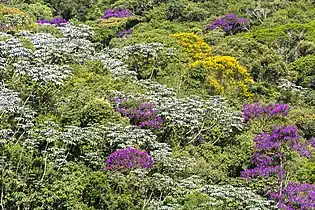Pleroma granulosum
Pleroma granulosum, synonym Tibouchina granulosa,[1] is a species of tree in the family Melastomataceae. It is also known as purple glory tree or princess flower.[2] It is native to Bolivia and Brazil. Because its purple-flowers bloom for most of the year, this tree is often used for gardening in Brazil, where is known by the name quaresmeira.[3]
| Pleroma granulosum | |
|---|---|
 | |
| In cultivation in São Paulo, Brazil | |
| Scientific classification | |
| Kingdom: | Plantae |
| Clade: | Tracheophytes |
| Clade: | Angiosperms |
| Clade: | Eudicots |
| Clade: | Rosids |
| Order: | Myrtales |
| Family: | Melastomataceae |
| Genus: | Pleroma |
| Species: | P. granulosum |
| Binomial name | |
| Pleroma granulosum | |
| Synonyms[1] | |
| |
Cultivation
Considered as one of the most ornamental species of the tropical flora for the foliage as well as for the abundant flowering, which lasts from spring to late autumn, it is widely cultivable in the tropical and subtropical climate zones.[3]
This tree can grow up to 10 metres in height and needs good drainage acidic soil in order to flowering. The use of an acid fertilizer is recommended. It will grow in full to partial sun, needs average water, and below freezing temperatures should be avoided.[4]
This tree can grows in USDA hardiness zone 10b to 11 or in any areas that do not exude too much cold.[5]
Pleroma granulosum can withstand sub-freezing temperatures for several hours, but if low temperatures extend for a longer period, they might damage the plant's leaves, stems and sprouts. When this happens, the roots usually survive and produce new upper growth the following spring. Although the plant can perform a quick recovery, it might not bloom, since it puts most of its energy into producing new stems and leaves.[6]
 In habitat (plants with purple flowers), near the Parque Nacional do Caparaó, Brazil
In habitat (plants with purple flowers), near the Parque Nacional do Caparaó, Brazil_1.jpg.webp) Flowers and leaves
Flowers and leaves_(28789167992).jpg.webp) Young trees for sale
Young trees for sale Pink-flowered cultivar ('Kathleen')
Pink-flowered cultivar ('Kathleen')
References
- "Pleroma granulosum (Desr.) D.Don". Plants of the World Online. Royal Botanic Gardens, Kew. Retrieved 2022-05-04.
- "Tibouchina Tree". www.south-florida-plant-guide.com. Retrieved 2020-01-29.
- Mazza, Giuseppe (2013-04-08). "Tibouchina granulosa". Monaco Nature Encyclopedia. Retrieved 2020-01-29.
- XIII Encontro Latino Americano de Iniciação Científica e IX Encontro Latino Americano de Pós-Graduação – Universidade do Vale do Paraíba 1ESTUDO FENOLÓGICO DA ESPÉCIE Tibouchina granulosa NA UNIVERSIDADE DO VALE DO PARAÍBA, CAMPUS URBANOVA, SÃO JOSÉ DOS CAMPOS – SP inicepg.univap.br Retrieved 29 January 2020
- "Tibouchina Tree: How to Grow and Care for the Purple Glory Tree". 10 May 2017.
- "Does a Purple Glory Tree die in the Frost?".